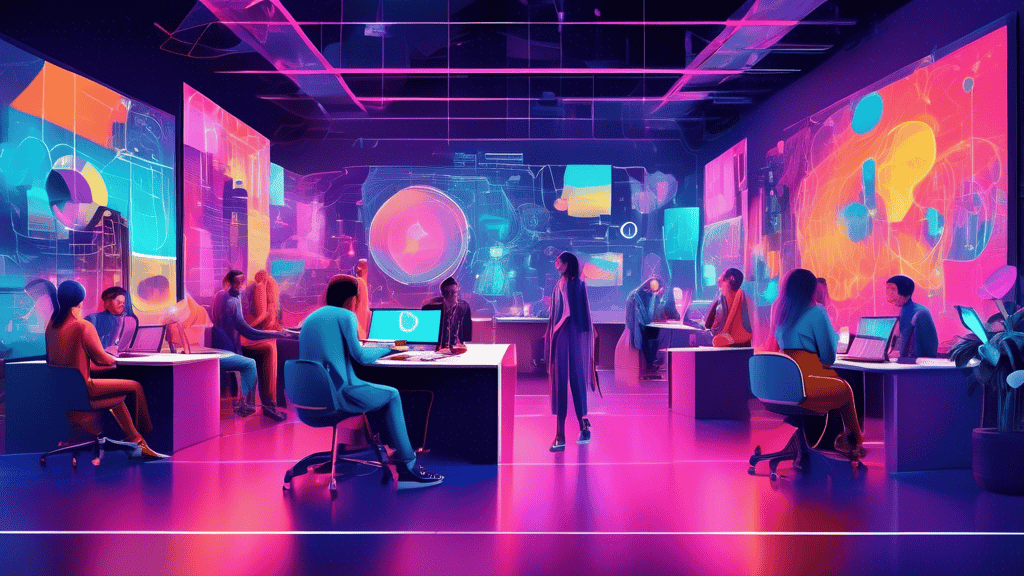Generative ai tools are rapidly transforming the way individuals and businesses create content, automate processes, and enhance productivity. These sophisticated tools leverage advanced algorithms to generate text, images, and even code, pushing boundaries in creativity and efficiency. As the digital landscape evolves, the importance of incorporating generative ai tools has never been more pronounced. Their relevance is underscored by significant growth statistics, indicating a surge in usage across various sectors.
Organizations utilizing generative ai tools unlock new avenues for innovation and improve overall workflow. From small startups to large enterprises, these tools provide an accessible means of optimizing resources and reducing costs. The impact is visible in diverse industries, all reaping the benefits of this technology.
This exploration into generative ai tools will delve deeper into their key benefits, real-world applications, and case studies that highlight transformative success stories. By understanding these elements, I aim to give you a comprehensive view of how generative ai tools are shaping the future of content creation and business operations.
## Introduction to Generative AI Tools
Generative ai tools are a class of artificial intelligence systems that can create new content, from text and images to music and video. These tools utilize machine learning algorithms, particularly those based on deep learning techniques, to analyze existing data and generate original content that mimics human-like creativity. By leveraging vast datasets, they can produce outputs that are not only coherent but also contextually relevant.
### Importance and Relevance in Today’s Digital Landscape
In our increasingly digital environment, the relevance of generative ai tools cannot be overstated. These tools are shaping how businesses operate, enabling new creative possibilities, and optimizing processes across various sectors. Here are a few reasons why they are crucial:
– **Innovation Catalyst**: Generative ai tools spark innovation by providing fresh perspectives and ideas, helping creators push boundaries.
– **Content Generation**: They alleviate the burden of content creation for marketing teams, ensuring that businesses can maintain a steady flow of high-quality material.
– **Decision Support**: By generating simulations and predictive models, these tools support analytics and decision-making across industries.
As digital content continues to proliferate, the need for efficient and effective means of production grows, putting generative ai tools at the forefront.
### Key Statistics Highlighting Usage and Growth
The surge in popularity of generative ai tools is backed by compelling statistics, signaling their rapid growth and adoption across various fields. Here are some key insights to consider:
– **Market Size**: The generative AI market was valued at approximately $8 billion in 2022 and is projected to reach over $110 billion by 2030, reflecting a staggering compound annual growth rate (CAGR) of around 40%.
– **Business Adoption**: A survey indicated that over 60% of companies are actively implementing generative AI solutions within their operations.
– **Impact on Content Production**: Businesses using generative ai tools report up to a 50% reduction in time spent on content creation, allowing teams to focus on strategy and execution.
These figures highlight not only the growing significance of generative ai tools but also their transformative potential within the digital landscape. Embracing these tools can lead to greater efficiency and innovation for businesses of all sizes.

## Key Benefits of Using Generative AI Tools
### Enhanced Creativity and Innovation in Content Creation
Generative ai tools significantly boost creativity across various domains. By leveraging advanced algorithms, these tools can generate unique content, whether it’s text, images, music, or videos. Here’s how they contribute to creative processes:
– **Idea Generation:** They can produce numerous ideas quickly, making brainstorming sessions more productive. I’ve seen how a simple prompt can yield various directions for an article or campaign.
– **Creative Suggestions:** These tools suggest improvements or variations on existing content, sparking new ideas and angles that might not have been considered. This can open up fresh narratives and artistic expressions.
– **Personalized Content:** Generative AI can tailor content to meet specific audience needs and preferences, enhancing user engagement and relevance in marketing strategies.
By incorporating generative AI tools, creators can push the boundaries of their work, exploring concepts they might not have ventured into otherwise.
### Streamlining Workflow and Increasing Efficiency
Operational efficiency is crucial in today’s fast-paced environment, and generative ai tools excel in this area. They help streamline workflows and minimize the time spent on repetitive tasks, allowing for more focus on creative and strategic aspects. Here are the main advantages:
– **Automating Routine Tasks:** From drafting reports to producing graphics, generative AI can handle monotonous tasks, freeing up valuable time for teams to focus on high-value activities.
– **Rapid Prototyping:** These tools enable quick generation of prototypes, whether it’s for a marketing campaign or product design, allowing for faster testing and iteration cycles.
– **Collaborative Features:** Many generative ai tools offer collaboration functionalities, enabling teams to work together seamlessly, regardless of location. This can lead to more cohesive projects and faster feedback loops.
Using generative ai tools can significantly enhance team productivity, enabling businesses to adapt swiftly to changing demands.
### Cost-Effectiveness and Accessibility for Businesses of All Sizes
Generative ai tools are becoming increasingly accessible and budget-friendly, providing various businesses with opportunities to leverage high-tech solutions without breaking the bank. Here’s how they offer cost benefits:
– **Reduction in Labor Costs:** By automating content creation and other tasks, generative AI can significantly cut down on human labor costs. Small businesses in particular can benefit from this capability, allowing them to allocate resources more efficiently.
– **Subscription Models:** Many generative ai tools offer subscription-based pricing, making them accessible to startups and smaller organizations that might not have had the budget for such technology before. This democratizes access to innovative tools that enhance professional outcomes.
– **Lower Production Costs:** With automated design and content generation, businesses can reduce production expenses, whether it’s for marketing materials or product samples. This means higher margins and competitive pricing strategies.
Generative ai tools are no longer just for large corporations. Their cost-effectiveness is making them a viable option for businesses of all sizes.
### Final Thoughts
Integrating generative ai tools can elevate creativity, optimize efficiency, and reduce costs in remarkable ways. As these technologies evolve and become more integrated into daily operations, they can transform the way industries approach tasks and challenges. Embracing generative AI leads to not only improved workflows but also enhanced outcomes and innovative results within competitive markets.

## Real-World Applications and Case Studies
Generative ai tools are making waves across various industries, showcasing their versatility and impact. Here, I’ll explore some of the significant sectors benefiting from these tools and highlight success stories of companies that have transformed their processes using this innovative technology. Additionally, I’ll touch on future trends and potential developments expected in the coming years.
### Examples of Industries Benefiting from Generative AI Tools
Several industries are adopting generative ai tools to enhance their capabilities. Here are just a few where these tools are having a notable impact:
– **Healthcare:** Generative AI is being used in drug discovery, where algorithms can predict molecular behavior, significantly accelerating the research and development timeline. It can also assist in patient diagnostics through image analysis.
– **Entertainment and Media:** Content creation has been revolutionized by AI-generated scripts, music, and artwork, allowing creators to brainstorm and produce original materials quickly and efficiently.
– **Marketing and Advertising:** Marketers leverage generative ai tools for creating personalized content at scale. These tools analyze consumer data to generate targeted ad campaigns that resonate more effectively with audiences.
– **Finance:** Financial institutions use generative models to detect fraudulent activities by recognizing patterns and anomalies in transaction data, thus safeguarding customer accounts and minimizing risks.
– **Gaming:** ai tools help in creating complex environments and narratives, offering a more immersive gaming experience. Developers can generate levels, characters, and even dialogue that respond dynamically to player choices.
### Success Stories: Companies that Transformed Their Processes
Several companies have successfully integrated generative ai tools into their operations, leading to impressive outcomes. Here are notable examples:
– **OpenAI:** By developing advanced language models, OpenAI has transformed the way individuals and businesses create content. From drafting articles to generating code, their tools have redefined user productivity and creativity.
– **Adobe:** The introduction of Adobe Sensei illustrates how generative AI can enhance creative processes. This tool helps designers automate mundane tasks like resizing or retouching, enabling them to focus on more innovative aspects of their projects.
– **Netflix:** By using generative AI for content recommendation systems, Netflix can analyze viewer preferences to suggest shows and movies effectively. This level of personalization keeps subscribers engaged and enhances user satisfaction.
– **BMW:** The automotive giant employs generative AI in product design and manufacturing processes. By modeling various design iterations quickly, they can optimize vehicles for performance and aesthetics, resulting in better customer satisfaction and reduced development time.
– **Zalando:** As an online fashion retailer, Zalando leverages generative ai tools to enhance their merchandising strategies. They use AI-generated models for better visualization of clothing on different body types, leading to improved customer engagement and increased sales.
### Future Trends: Potential Developments and Impact on Various Sectors
The future holds exciting possibilities for generative AI tools, with predicted advancements that could further transform industries. Some trends to look for include:
– **Improved Human-AI Collaboration:** As AI systems become more adaptive, we can expect enhanced collaboration between humans and machines. Generative ai tools will serve as creative partners, inspiring professionals rather than replacing them.
– **Greater Customization:** Generative ai tools will provide even more personalized experiences across various sectors. From shopping to entertainment, businesses will tailor their offerings based on individual user data more efficiently.
– **Ethical AI Development:** With the rise of AI technologies, there will be increased focus on ethical considerations. Companies will prioritize responsible AI usage to ensure fairness and transparency in their applications.
– **Enhanced Predictive Capabilities:** Future generative ai tools will improve their ability to predict trends based on vast data sets. This advancement will empower industries like finance, healthcare, and retail to make more informed decisions.
– **Integration with Other Technologies:** Expect generative ai tools to integrate seamlessly with other emerging technologies, such as augmented reality (AR) and virtual reality (VR). This combination will create immersive experiences in fields like education, training, and entertainment.
Generative ai tools are reshaping the landscape across numerous domains, providing innovative solutions and driving efficiency. From healthcare advancements to creative industries embracing originality, the impact is undeniable. With numerous success stories showcasing their effectiveness and promising trends on the horizon, it’s evident that embracing generative ai tools may just be the key to staying competitive in the evolving marketplace.
Generative ai tools offer a transformative approach to various aspects of digital creation and business processes. Their ability to enhance creativity fosters a new wave of innovation, enabling creators to produce unique content more efficiently. By streamlining workflows, these tools not only improve productivity but also allow teams to focus on strategic initiatives rather than repetitive tasks.
Businesses of all sizes find these tools cost-effective, making advanced technology accessible without hefty investments. The case studies discussed illustrate just how impactful generative AI can be across different industries, from entertainment to marketing, showcasing successful transformations and the potential for future growth.
As we continue embracing advancements in AI, the scope of generative tools will likely expand further. Staying informed about these developments can empower individuals and organizations to leverage AI effectively for their own benefit, ensuring they remain competitive and relevant in this digitally-driven landscape. Engaging with generative ai tools is not just a trend—it’s a strategic move toward future success.
